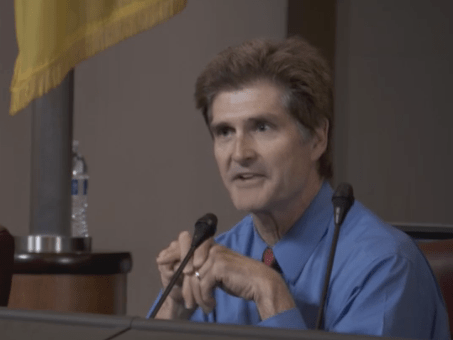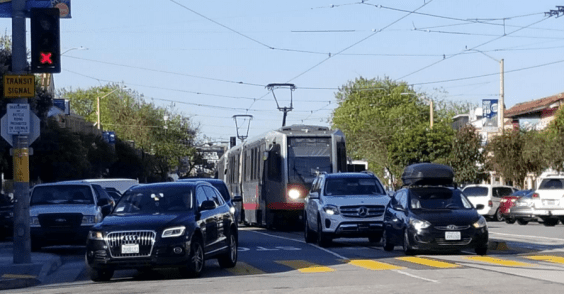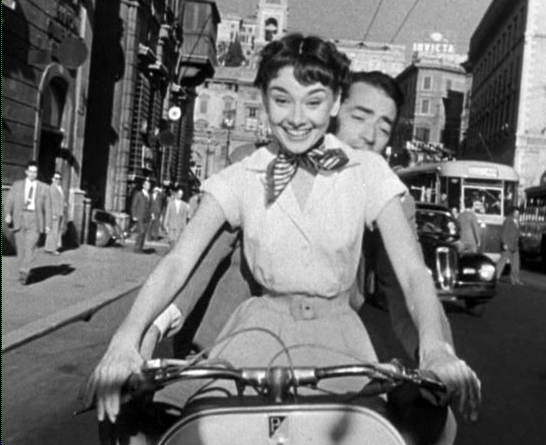California Transportation Commissioners Question CalBike, and Need for Equity Lens
12:13 PM PDT on August 25, 2017

California Transportation Commissioner Carl Guardino questions California Bicycle Coalition representative Jared Sanchez. Image: Screengrab from CTC
At its meeting last week, several members of the California Transportation Commission (CTC) sharply questioned representatives of the California Bicycle Coalition about its stance on a number of issues unrelated to the matter at hand. The exchange was jarring, in part because their questions came out of left field.
But also because the commissioners seemed to object to CalBike weighing in at all on how funding from S.B. 1, the recently passed gas tax measure, should be allocated.
Worse, some of their questions revealed a disturbing misunderstanding of how transportation funding works in California. That is not good, as the CTC is the main decision-making body that allocates funding for transportation projects in the state.
The confusing conversation underscored the need for representation on the commission by people who better understand these issues—and the lost opportunity of a watered-down bill, A.B. 179, that could have improved the situation. (You can listen for yourself at this link here; look for the August 16, 2017 meeting, Part 2, and begin about thirty minutes in.)
The whole exchange started when Jared Sanchez, representing CalBike, commented on funding allocations under S.B. 1, which not only raised the gas tax but has created a slew of new programs. The commission was discussing and taking comments on draft guidelines for several of those programs.
For the last several years, CalBike and some of its partner organizations have been shifting their understanding of what bike advocacy means, recognizing that social and environmental justice issues are connected to their advocacy for better, more accessible streets for all. Sanchez spoke in support of a letter submitted by a coalition of partners that outlined ten principles of transportation justice they wanted the CTC to consider when allocating funds.
Instead of responding about the principles, Commissioner James Ghielmetti asked Sanchez about a completely unrelated issue: CalBike's position on a bicycle license fee. Note that a bicycle license fee is not part of S.B. 1 and has not been part of California's conversation around transportation funding. The question came out of nowhere.
Sanchez, unprepared for it, said he was not sure. Commissioner Ghielmetti apparently didn't hear his response. “We used to have one,” said Ghielmetti, “and I don't understand what the objection would be.”
Commissioner Yvonne Burke broke in to say, “No one wants to be bothered with it. It's a small amount of money. But you might make [things easier for] a lot of young people who lose their bicycles.”
Commissioner Carl Guardino took the opportunity to lecture Sanchez. “I'm also old enough to remember taking my bike to the fire station to do that,” he said. “It's a shared responsibility model. We are all Californians. We are all together in trying to have transportation improvements, including active transportation.”
“As someone who bikes around ten thousand miles a year—more than half my daily commute,” he said, “I think it would be wise, inexpensive, and would show our commitment as people on two wheels that costs should not be borne only by people on four wheels.”
Sanchez, perhaps trying to bring the conversation back to the subject at hand, replied that “maybe next year we could make it an eleventh principle, but it didn't make the cut for this list.”
Maybe the commissioners were trying to draw a connection between CalBike's support of justice issues and what they see as a hypocritical stance in opposition to a bike license fee. That is only conjecture, though--they didn't specify why the subject came up.
They also didn't fully engage with the issue. To be fair, it wasn't on the agenda. But a full discussion would be useful for them. For one, the commissioners don't seem to have the same idea what the purpose of a bike license fee would be. At least Commissioner Burke acknowledged that such a fee would raise very little revenue; bike license fee programs rarely raise enough money to pay for program costs. The commissioners appear to be unaware that a free, nationwide bike registration program to help recover stolen bicycles already exists (BikeIndex, and go register your bike right now).
But Guardino's claim that paying a bike license fee would in any way make transportation funding “fairer” by having bicyclists pay something for their transportation infrastructure is not very well-informed, to put it mildly. He, of all people, should know that at least half of transportation funding in California comes from sales taxes that everyone pays, whether they drive a car or not. He should realize that people who don't drive on freeways are subsidizing those who do, not the other way around.
It felt like the commission had it out for CalBike. When, a few minutes later, Sanchez came back to the microphone to weigh in on draft guidelines for the State Transportation Improvement Program (STIP), one of the programs getting money from S.B. 1, they once again ignored his comments. Instead, Commissioner Lucy Dunn called Sanchez back to the microphone to ask whether CalBike had supported the passage of S.B. 1. “No,” was Sanchez's answer.
Then Guardino went a bit off the rails. “In your short statement, you mentioned underserved and disadvantaged communities four times, and no one else,” he said. “I hope the California Bicycle Coalition supports bicycling and active transportation for everyone. My children ride to school on terrible roads, but I want them to have the same safety as all kids in California. Is that the view of the coalition? Your comments didn't reflect that,” he said.
Note that Sanchez had been commenting on recommendations from CalBike and its coalition partners for the STIP—not the Active Transportation Program (ATP). Their suggestions included greater transparency on exactly how funds used to benefit underserved and overburdened communities would be spent and how those funds would provide benefits, as well as a clear commitment to making sure that underserved communities receive investments from the program.
Sanchez tried to point out that a body of research shows a large share of people who live in areas without decent bicycle and pedestrian access are low-income and overburdened communities—ones that suffer larger health and other burdens from pollution. But Guardino wasn't having it.
“We have underinvested everywhere,” he said. Meanwhile his city, San Jose, has “done such a good job of integrating all income levels throughout the community, instead of what many communities do of having [large] pockets of poverty.” Because of that, San Jose has been stiffed in ATP allocations: the city, he said, received only one small allocation from the ATP during its short existence.
“If I hear you right, San Jose will continue to be penalized,” he said. “My point is: yes, we should absolutely do everything we can for underserved communities. We also can't forget children in all of our communities.”
Of course, there is the small fact that the ATP has not had anywhere near enough money to fund more than a small proportion of the eligible projects that apply for it. San Jose is one in a very long line of worthy applicants.
“I would like you to take back—not next year, but to our next meeting—to the California Bicycle Coalition, from this cyclist, who pedals what he preaches, how we're going to make sure we're fighting for all kids and all residents to achieve these benefits,” Guardino said to Sanchez. “And a deeper understanding about, when a lot of us were doing everything we could for the last two and a half years to make any of these sources of funding available through S.B. 1, why the coalition was still opposed to it.”
Later, CalBike policy director Jeanie Ward Waller tried to clarify. “S.B.1 was a hard one for us,” she said. CalBike's official position, in the end, was “oppose unless amended,” because the bill included a provision that exempted diesel trucks from some pollution oversight.
“We worked in coalition with a huge number of groups that were trying really hard to get agreement,” said Ward Waller. “I'm sure those of you who work in politics understand how hard it can be when you have a large coalition and you need to come to an agreement. We just couldn't get there.”
Nevertheless, she said, “We appreciate [the bill's] funding for active transportation and of course the funding for transit. We want to work with you, and we want to support implementation of S.B. 1's programs. And we acknowledge that the funding is for all Californians, not just those who supported S.B. 1.”
At that point, Guardino again brought up the question of a bicycle license fee. “Your colleague may have misunderstood,” he said. “He said he would come back to us in a year—I hope he was misspeaking.”
“Our position is that we don't support it,” said Ward Waller. “But we look forward to having that conversation with you.”
A comment that couldn't be heard well because Commissioner Dunn's microphone was turned off brought Ward Waller back to the microphone again. No, she was not referring to S.B. 1. “We are not supporting a repeal of S.B. 1,” said Ward Waller.
By the way, A.B. 179, in its watered-down form, is moving forward. Instead of requiring a minimum number of commissioners to have a working knowledge of the issues of underserved communities, it now merely requires that the governor, in his process of appointing commissioners, "use every effort to ensure that the commission has a diverse membership, . . . taking into consideration. . . socioeconomic background and professional experience, which may include experience working in, or representing, disadvantaged communities."
Given the current commissioners' negative, and digressive, reactions to public comments calling for transportation equity and justice, this does not sound like it will be strong enough.
Streetsblog California editor Melanie Curry has been thinking about transportation, and how to improve conditions for bicyclists, ever since commuting to school by bike long before bike lanes were a thing. She was Managing Editor at the East Bay Express, editor of Access Magazine for the University of California Transportation Center, and earned her Masters in City Planning from UC Berkeley.
Read More:
Stay in touch
Sign up for our free newsletter
More from Streetsblog California
State E-bike Incentive Program Update
E-bike battery certification requirements, and get ready now for the first launch window.
Commentary: Merchants Are Getting People Killed
The number one local obstruction to curbing traffic violence is local commerce and merchant groups.
Freeway Drivers Keep Slamming into Bridge Railing in Griffith Park
Drivers keep smashing the Riverside Drive Bridge railing - plus a few other Griffith Park bike/walk updates
Wednesday’s Headlines
Bike Month begins; Transit dangers; Yolo causeway project "not air quality concern" and Sacramento gets an F in air quality; Universal basic income could get a lot of people off the streets; More




